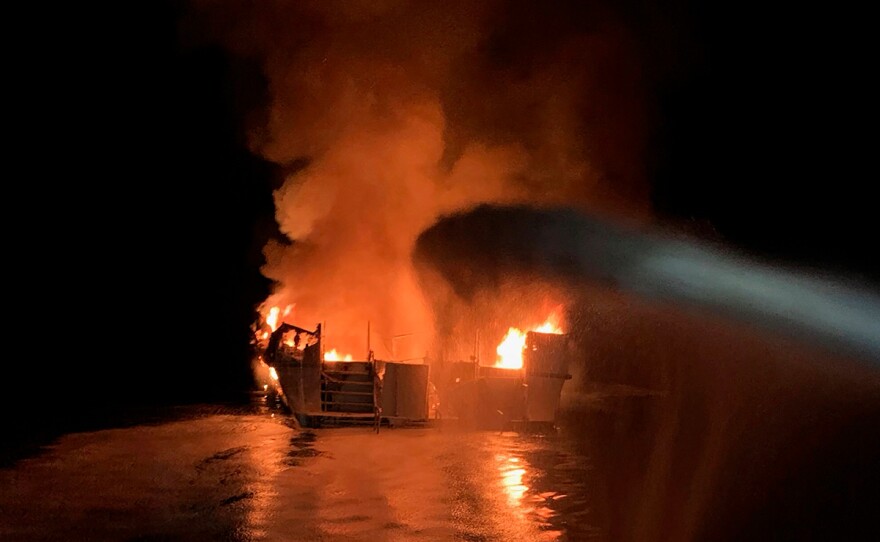Crew members on a dive boat say they were never instructed on emergency procedures before a predawn fire swept through the vessel as it was anchored off the southern California coast, killing 34 people as they slept below deck, according to federal documents released Wednesday.
National Transportation Safety Board investigators say the cause of the blaze aboard the Conception remains undetermined but a possible ignition point was phones and other electronics plugged into outlets. One crew member told investigators he saw sparks flash when he plugged in his cellphone hours before the fire.
The boat was carrying 33 passengers on a Labor Day weekend scuba diving expedition last year. The fire broke out on the trip's final night as the Conception was anchored off Santa Cruz Island, about 25 miles (40 kilometers) south of Santa Barbara, the boat's home port.
All of the passengers and one crew member sleeping below deck were killed. The other five crew members, including Capt. Jerry Boylan, survived. They barely escaped after trying in vain to save the others, authorities said. Boylan made a mayday call at 3:14 a.m., saying, “I can’t breathe,” before abandoning ship.
Boylan could face federal manslaughter counts, and recent court documents say criminal charges are imminent. The NTSB has said all six crew members were asleep when the fire broke out, a violation of Coast Guard regulations that require a roving watch.
RELATED: Officials: Fire Blocked Escape For 34 Divers Asleep On Boat
Hundreds of pages of documents released by the safety board provide a detailed look at the boat’s final hours on Sept. 2, 2019. The five-person NTSB will hold an Oct. 20 meeting to vote on the investigation’s findings, as well as the blaze’s probable cause and any potential recommendations.
Ryan Sims, who had only been working aboard the boat for three weeks, told investigators he had asked the captain to discuss emergency plans the day before the fire. Boylan reportedly told him: “When we have time.”
“I didn’t know what the procedures were supposed to be,” Sims said. Other crew members also said they were not familiar with safety procedures.
Sims told investigators he went to sleep after seeing sparks when he plugged in his cellphone, and there is no indication in the documents that he reported what he saw.
Sims, who broke his leg trying to escape the burning boat, has sued the vessel’s owners and the company that chartered it, alleging that the Conception wasn't seaworthy and operated in an unsafe manner.
Families of 32 of the victims and another surviving crew member have filed claims against the boat owners, Glen and Dana Fritzler, and the boat company, Truth Aquatics. In turn, the Fritzlers and the company have filed a legal claim to shield them from damages under a maritime law that limits liability for vessel owners. Court filings show they have offered to settle lawsuits with dozens of victims’ relatives.
Attorneys for Sims, Boylan and the Fritzlers did not immediately return requests for comment. A spokesman for the U.S. attorney’s office in Los Angeles that is investigating the case declined to comment.
Boylan and the Fritzlers had a good reputation with customers and the Santa Barbara boating community before the tragedy. Coast Guard records show the Conception had passed its two most recent safety inspections without violations.
In 2018, the Conception’s sister boat — the Vision — had a small fire involving a lithium-ion battery that was charging. A Coast Guard inspection of the Vision after the Conception’s fire found 40 violations, including 11 related to fire safety. An inspection just months before had not found any violations.
Passengers on the Conception slept in tiered bunks below the main deck. A staircase at one end of the bunk room led up to the galley, as did an escape hatch measuring 22 inches by 22 inches (56 centimeters) that was above an upper bunk and away from the staircase.
NTSB board member Jennifer Homendy noted how difficult it was to reach the hatch when she toured the Vision.
The documents on the investigation say the Conception's escape hatch was typically discussed during safety briefings but passengers were not shown where it was.
Kyle McAvoy, a marine safety specialist with Robson Forensic in Philadelphia who often is an expert witness in trials, said use of the hatch should have been discussed at a safety briefing but that it's required that it be “fairly clear and obvious” how to open it.
While interviewing Cullen Molitor, the boat's second captain under Boylan, local investigators and those from the NTSB and Coast Guard asked multiple questions about items plugged into electrical outlets in the Conception’s galley.
Molitor said that in the back of the galley, there are outlets where divers plugged in flashlights, camera equipment, strobe lights and cellphones the night of the fire. He estimated there were 10 to 20 items plugged in on one side and five to 15 on the other, with at least one power strip, although he said he didn’t know for sure, according to a transcript of the interview.
The Coast Guard has issued additional safety recommendations in the wake of the tragedy, such as limiting the unsupervised charging of lithium-ion batteries and the use of power strips and extension cords.
Molitor also said there were two smoke detectors in the bunkroom and two in the galley, but he didn’t hear any alarms after another crew member woke him up. He wasn’t sure if they were all wired together to sound at once but said he would expect to hear them from where he was sleeping.
“One thing we never heard was any screams or banging or anything from the boat, both while we were on it or when we were close, nearby. It was just flames. I never heard any alarms go off,” Molitor said.







